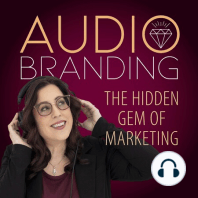20 min listen
A World of Living Sound
FromAudio Branding
ratings:
Length:
7 minutes
Released:
Dec 2, 2020
Format:
Podcast episode
Description
So much has changed about our world, from one century to the next, even from year to year. Just imagine taking someone even from the 1980s and dropping them into the world we live in right now, much less someone from a hundred or two hundred years ago. But all the way back through history, as far back as the dinosaurs and even much further, there are sounds that we’d still instantly recognize today. Let’s take a closer look at that timeless world of sound and what can happen when we start to add our own sounds to it. Composer Pauline Oliveros (pronounced “Oh-lee-vehr-ohs”) defined the word “soundscape” as “all of the waveforms faithfully transmitted to our audio cortex by the ear and its mechanisms.” The soundscape of the Earth can be divided into three layers, and those three layers happen to reflect the history of the world itself and how much it’s changed.First there’s “geophony,” sounds that come from natural forces like rain or wind. It can be as dramatic as an erupting volcano, or as gentle as a stream. These were literally the first sounds in the world. One of the most familiar sounds today started billions of years ago as the Earth cooled and water vapor began to condense into rain. That rain fell for centuries and soon became another familiar sound: the sound of the oceans lapping the shore.Then there’s “biophony,” which is the sound that comes from living things. This is where things get really interesting and complicated. It’s pretty much impossible to imagine a forest without thinking of the birds chirping in the treetops. Whale songs literally fill the ocean, echoing from continent to continent. Just within this past decade we’ve even discovered that mice sing to each other at frequencies too high for our ears to pick up. Check out my blog for a link to a video clip of a male lab mouse literally singing to his mate.https://youtu.be/ZS4Chf9yh8sThis makes mice one of the very few mammals to have their own mating song – unless, of course, you count people. That brings us to “anthropophony,” which is all the sounds that human beings make. For a long time the only sounds that we could add to this soundscape were our own voices. But then we began to use tools. We started singing, clapping, and creating musical instruments to invent all sorts of new sounds never heard before. But we also invented tools and machines that are quite loud without meaning to be, machines that make noise instead of music. We call that sub-layer of sound “technophony.” Traffic jams, airplanes, subways, construction work, these are the sounds that we usually think of whenever we think about life in the city. Those sorts of sounds are becoming a big problem for the rest of the soundscape, a problem we now call noise pollution.There’s a link on my blog to Cedric Engels’ fascinating video “Sound Ecology: A Better Sounding Planet” that offers a more detailed look at each layer of sound.https://youtu.be/Vtfro7tzXDgNoise pollution, that loud, messy layer of sound that our modern world creates, can disrupt the biophony that makes up the rest of the natural world. Animals aren’t just listening to their own species, but to every sound in their natural environment. Each species carves out a spot for its own unique voice. Cicadas, crickets, frogs and birds have each developed a distinctive acoustic bandwidth so that, even though they all share the same environment, they aren’t shouting over each other. You’ll also find a short video on my blog of a dawn chorus of birds in England. Notice how, even with all sorts of different animals singing at the same time, you don’t have any trouble telling which one is which.https://youtu.be/r6_LYIdYxz4Noise pollution drowns out that natural bandwidth, making it harder and harder for animals to hear each other, to attract mates or even hunt for food. In the ocean, where the soundscape is much louder and even more important, sound pollution from ships,...
Released:
Dec 2, 2020
Format:
Podcast episode
Titles in the series (100)
Interview with Global Brand Strategist, Edward Farley – Part 1 by Audio Branding
